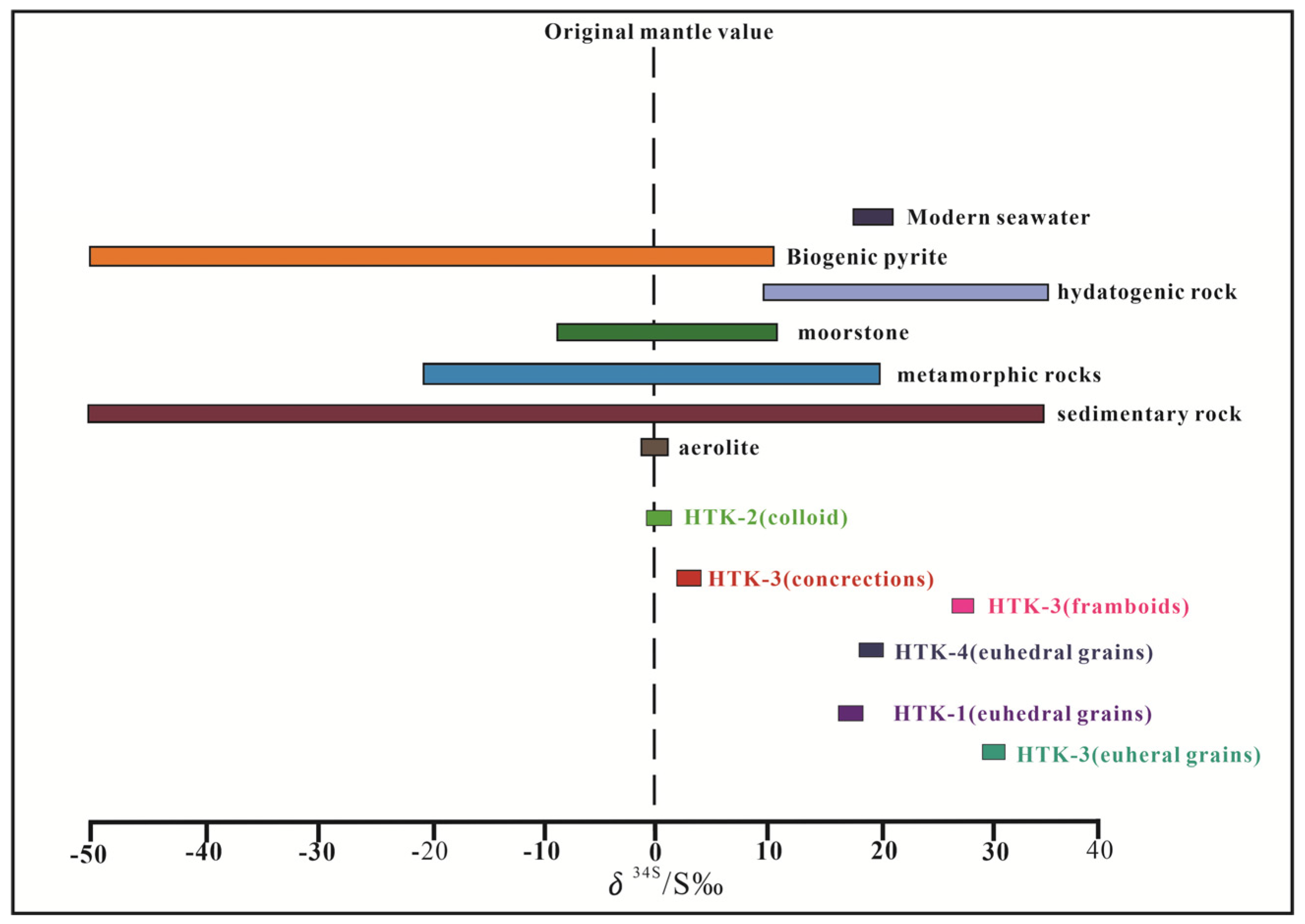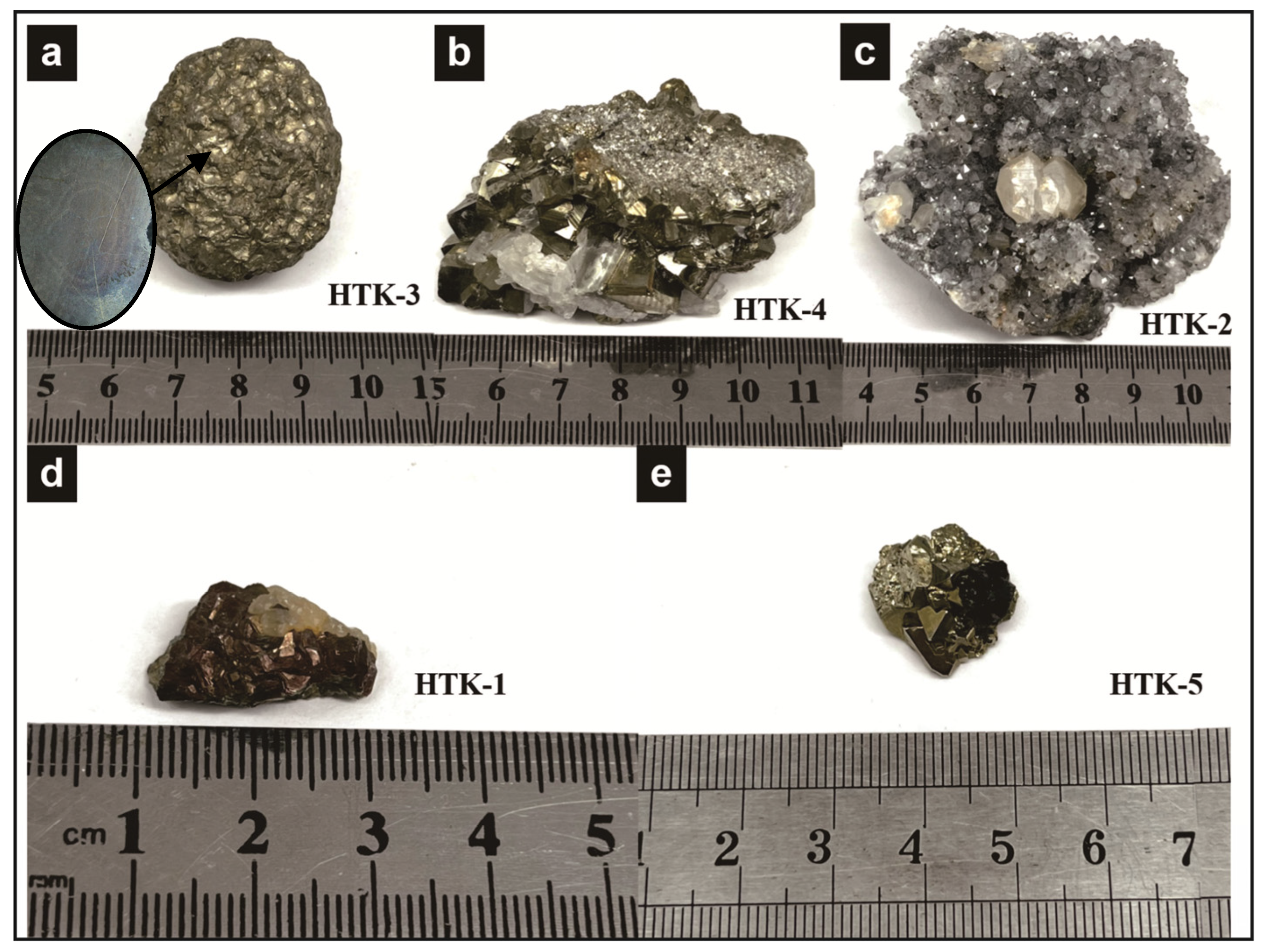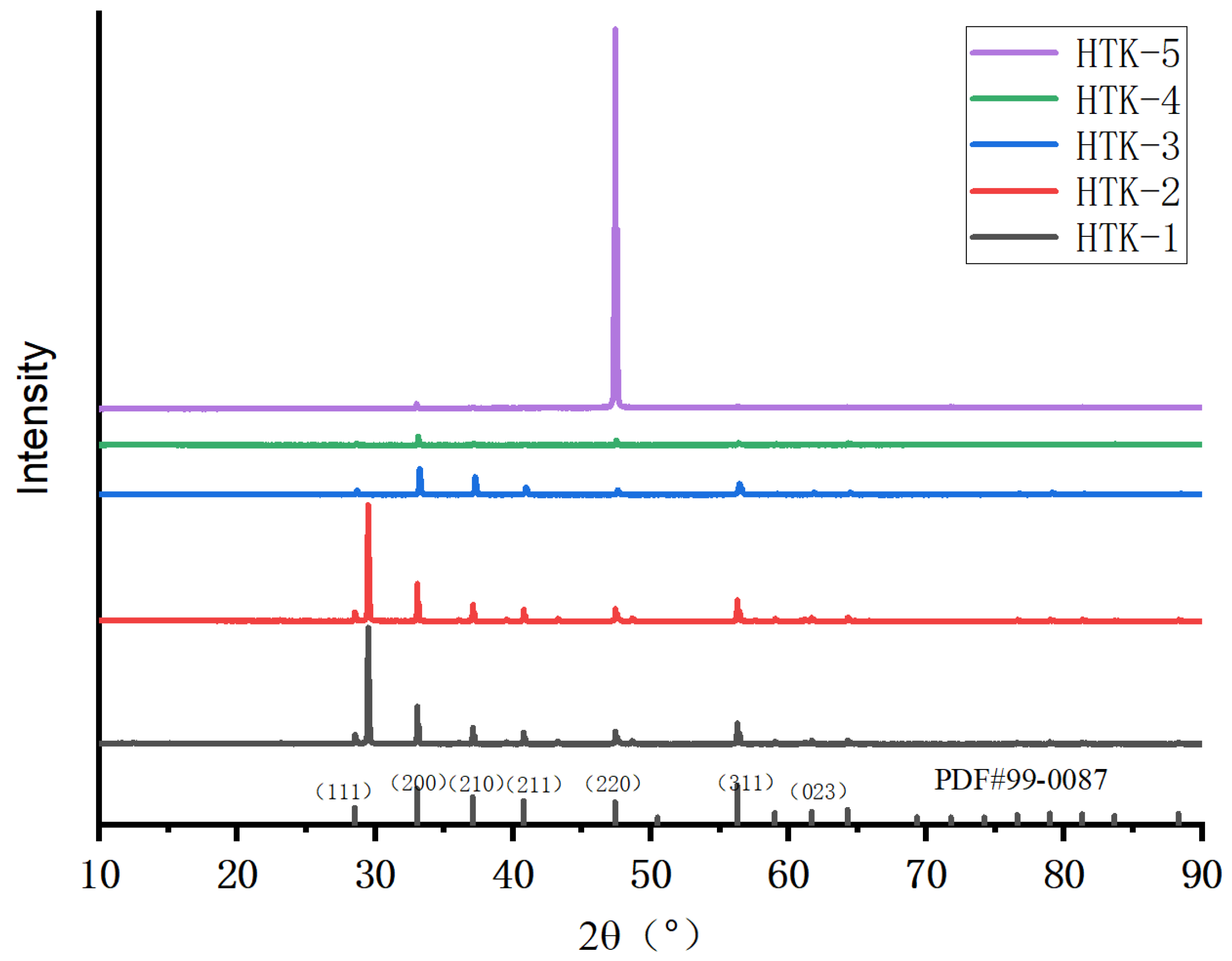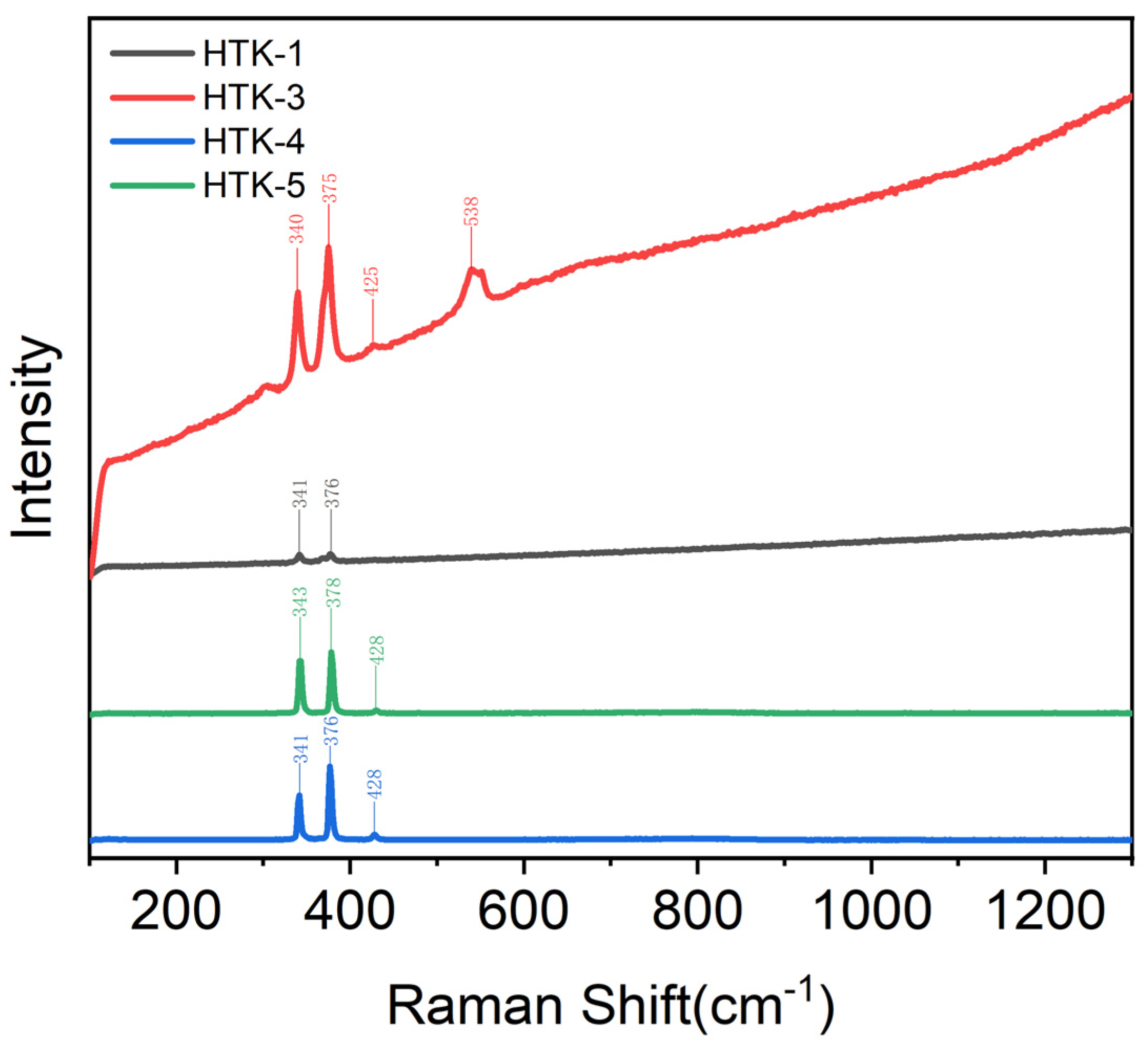Mineralogical Characteristics and Genetic Types of Pyrite with Different Occurrence: Constraints from Spectroscopy, Geochemistry and δ34S Stable Isotopes
Abstract
:1. Introduction
2. Materials and Methods
2.1. Sample Description
2.2. Methods
3. Results and Discussion
3.1. Pyrite Occurrence
3.2. X-ray Diffraction Analysis
3.3. Infrared Spectrum Analysis
3.4. Raman Spectrum Analysis
3.5. Major and Trace Elements Analysis
3.5.1. Major Elements Analysis
3.5.2. Trace Elements Analysis
4. S Stable Isotope
| Samples | Lithology | Mineral | Form | δ34S‰ |
|---|---|---|---|---|
| HTK-3 | sedimentary | Pyrite | euhedral grains | 29.15~31.01 |
| HTK-3 | sedimentary | Pyrite | framboids | 5.32~7.01 |
| HTK-3 | sedimentary | Pyrite | framboids | 29.96~30.86 |
| HTK-2 | hydrothermal | Pyrite | colloid | 0.15~2.37 |
| HTK-3 | sedimentary | Pyrite | concretions | 2.35~4.58 |
| HTK-4 | hydrothermal | Pyrite | euhedral grains | 18.34~20.92 |
| HTK-1 | hydrothermal | Pyrite | euhedral grains | 16.32~18.73 |

5. Conclusions
- (1)
- The presence of nodular pyrite formed during sedimentary processes indicated the sedimentary environment has been transitioned into an acidic sulfide reduction environment, with deeper formation depths, higher environmental pressure, and higher temperatures. Spectral and trace element analyses show this type of pyrite exhibits significant substitution of Fe by Co and Ni elements, and the pyrite crystallized in this environment shows higher and more diverse trace element contents.
- (2)
- The cubic pyrite in hydrothermal genesis has high crystallinity and is predominated by coarse-grained euhedral pyrite in the early stages and fine-grained pyrite in the late stages of mineralization, respectively. The ore-forming fluids may be in low-sulfur and high-oxygen fugacity environment, with high As and Cr contents in pyrite. Pentagonal decahedral polycrystalline pyrite grown in layered structure with high-temperature morphological characteristics, so the ore-forming fluids could be in the high-sulfur-concentration medium-temperature environment with high As, Bi, Pb, and Cu contents. Meanwhile, the octahedral pyrite presents good crystallinity and fewer spectral peaks in its spectral characteristics, and magmatic activity controls the formation of the deposit.
- (3)
- The sulfur isotope compositions suggest the sulfur sources in sedimentary pyrite are mainly granite and sedimentary rocks, and the sulfate supply can be divided into two cases: SO42− open system and SO42− closed system, respectively. The sulfur sources of hydrothermal pyrite exhibit mixed sulfur characteristics, indicate a dominant mantle sulfur signature with mixture of seawater sulfate sources.
Author Contributions
Funding
Data Availability Statement
Acknowledgments
Conflicts of Interest
References
- Bragg, W.L. The Analysis of Crystals by the X-ray Spectrometer. J. Proc. R. Soc. Lond. 1914, 613, 468–489. [Google Scholar]
- Cook, N.J. Mineralogy of the sulphide deposits at Sulitjelma, northern Norway. J. Ore Geol. Rev. 1996, 5, 303–338. [Google Scholar] [CrossRef]
- Liu, J.; Li, S.; Li, Z.; Liu, Q.; Guo, W.; Zhou, X.; Ma, X. Development characteristics and geological significance of shale pyrite in Chang 73 submember of Ordos Basin. Nat. Gas Geosci. 2021, 12, 1830–1838. [Google Scholar]
- Chu, F.Y.; Hu, D.Q.; Yu, H.L.; Yao, J. Significance of pyrite crystal morphology speciation in gold ore evaluation. J. Jilin Univ. Earth Sci. Ed. 2004, 4, 531–535. [Google Scholar]
- Zhang, G.; Nie, H.; Tang, X.; Du, W.; Sun, C.; Chen, S. Types of pyrite in shales and their effects on shale gas enrichment-A case study of Wufeng Formation-Longmaxi Formation shales in the Sichuan Basin and its periphery. Exp. Pet. Geol. 2020, 3, 459–466. [Google Scholar]
- Russo, R.E.; Mao, X.L.; Borisov, O.V.; Liu, H. Influence of wavelength on fractionation in laser ablation ICP-MS. J. Anal. At. Spectrom. 2000, 9, 1115–1120. [Google Scholar] [CrossRef]
- Sack, P.J.; Large, R.R.; Gregory, D.D. Geochemistry of shale and sedimentary pyrite as a proxy for gold fertility in the Selwyn basin area, Yukon. J. Miner. Depos. 2018, 7, 997–1018. [Google Scholar] [CrossRef]
- Shaheen, M.E.; Gagnon, J.E.; Fryer, B.J. Femtosecond (fs) la sers coupled with modern ICP-MS instruments provide new and improved potential for in situ elemental and isotopic analyses in the geosciences. J. Chem. Geol. 2012, 330, 260–273. [Google Scholar] [CrossRef]
- Reich, M.; Kesler, S.E.; Utsunomiya, S.; Palenik, C.S.; Chryssoulis, S.L.; Ewing, R.C. Solubility of gold in arsenian pyrite. J. Geochi Mica Cosmochim. Acta 2005, 11, 2781–2796. [Google Scholar] [CrossRef]
- Norris, A.; Danyushevsky, L. Towards Estimating the Complete Uncertainty Budget of Quantified Results Measured by LA-ICP MS; J. Goldschmidt: Boston, MA, USA, 2018. [Google Scholar]
- Peterson, E.C.; Mavrogenes, J.A. Linking high-grade gold min eralization to earthquake-induced fault-valve processes in the Porgera gold deposit, Papua New Guinea. J. Geol. 2014, 5, 383–386. [Google Scholar] [CrossRef]
- Chen, G.Y.; Shao, W.; Sun, D.S. Genetic Mineralogy of Gold Deposits in Jiaodong Region with Emphasis on Gold Prospecting; Chongqing Publishing House: Chongqing, China, 1989. [Google Scholar]
- Xie, Q.; Sun, S.; Ma, Z.; Xu, L.; Wang, J.; Zhou, Y.; Chen, T.; Xu, X. Mineralogical and metallogenic analysis of colloidal pyrite in the Baocungold (Cu) deposit, Tongling. Acta Geol. Sin. 2021, 5, 1481–1494. [Google Scholar]
- Norman, M.; Robinson, P.; Clark, D. Major-and trace-element analysis of sulfide ores by laser-ablation ICP-MS, solution ICP MS, and XRF: New data on international reference materials. J. Can. Mineral. 2003, 2, 293–305. [Google Scholar] [CrossRef]
- Müller, W.; Shelley, M.; Miller, P.; Broude, S. Initial performance metrics of a new custom-designed ArF excimer LA-ICPMS system coupled to a two-volume laser-ablation cell. J. Anal. At. Spectrom. 2009, 2, 209–214. [Google Scholar] [CrossRef]
- Rickard, D.; Luther, G.W. Chemistry of iron sulfides. J. Chem. Rev. 2007, 2, 514–562. [Google Scholar] [CrossRef]
- Mavrogonatos, C.; Voudouris, P.; Zaccarini, F. Multi-stage introduction of precious and critical metals in pyrite: A case study from the Ko nos Hill and Pagoni Rachi porphyry/epithermal prospects, NE Greece. J. Miner. 2020, 9, 784. [Google Scholar] [CrossRef]
- Yao, C.; Song, H.; Li, Q. Raman spectrum characterization of pyrite in the Jiaojia gold deposit in Jiaodong and its diagenetic significance. Spectrosc. Spectr. Anal. 2020, 8, 2479–2483. [Google Scholar]
- Han, Q.M. Current status of pyrite physicochemical speciation characterization. China Met. Bull. 2019, 6, 188–190. [Google Scholar]
- Huston, D.L.; Sie, S.H.; Suter, G.F.; Cooke, D.R.; Both, R.A. Trace elements in sulfide minerals from eastern Australian volcanichosted massive sulfide deposits; Part I, Proton microprobe analyses of pyrite, chalcopyrite, and sphalerite, and Part II, Selenium levels in pyrite; comparison with delta 34S values and implications for the source of sulfur in volcanogenic hydrothermal systems. Econ. Geol. 1995, 5, 1167–1196. [Google Scholar]
- Belousov, I.; Large, R.; Meffre, S.; Danyushevsky, L.; Steadman, J.; Beardsmore, T. Pyrite compositions from VHMS and orogenic Au deposits in the Yilgarn Craton, Western Australia: Implications for gold and copper exploration. J. Ore Geol. Rev. 2016, 79, 474–499. [Google Scholar] [CrossRef]
- Zhang, H.; Zhao, Q.; Zhao, G.; Hong, J.; Liu, J.; Zhai, D. Technical method for in situ microzonation analysis of pyrite trace elements by LA-ICP-MS and its application in the study of gold deposits. Geol. Ore Depos. 2023, 6, 1–18. [Google Scholar]
- Yan, Y.; Li, S.; Jia, B.; Zhang, N.; Yan, L. Characteristics of metallogenic speciation of pyrite composition during the metallogenic period of gold deposits of different genesis types. GOLD 2012, 3, 11–16. [Google Scholar]
- Román, N.; Reich, M.; Leisen, M.; Morata, D.; Barra, F.; Deditius, A.P. Geochemical and micro-textural fingerprints of boiling in pyrite. Geochim. Cosmochim. Acta 2019, 246, 60–85. [Google Scholar] [CrossRef]
- Gregory, D.D.; Large, R.R.; Halpin, J.A.; Baturina, E.L.; Lyons, T.W.; Wu, S.; Danyushevsky, L.; Sack, P.J.; Chappaz, A.; Maslennikov, V.V.; et al. Trace element content of sedimentary pyrite in black shales. J. Econ. Geol. 2015, 6, 1389–1410. [Google Scholar] [CrossRef]
- Li, W.; Cook, N.J.; Xie, G.Q.; Mao, J.W.; Ciobanu, C.L.; Li, J.W.; Zhang, Z.Y. Textures and trace element signatures of pyrite and arsenopyrite from the Gutaishan Au-Sb deposit, South China. Miner. Depos. 2019, 4, 591–610. [Google Scholar] [CrossRef]
- Liu, Y.; Xie, H.; Xu, L.; Ni, Z.; Lu, F.; Tan, H. Sulfur isotope geochemical characteristics of Ziziping lead-zinc deposit in Jiulong County, Sichuan Province. Geol. Bull. China 2020, 12, 8. [Google Scholar]
- Large, R.R.; Halpin, J.A.; Danyushevsky, L.V.; Maslennikov, V.V.; Bull, S.W.; Long, J.A.; Gregory, D.D.; Lounejeva, E.; Lyons, T.W.; Sack, P.J.; et al. Trace element content of sedimentary pyrite as a new proxy for deep-time ocean–atmosphere evolution. J. Earth Planet. Sci. Lett. 2014, 389, 209–220. [Google Scholar] [CrossRef]
- Ohmoto, H. Systematics of sulfur and carbon isotopes in hydrothermal ore deposits. Econ. Geol. 1972, 5, 551–578. [Google Scholar] [CrossRef]
- Keith, M.; Haase, K.M.; Klemd, R.; Krumm, S.; Strauss, H. Systematic variations of trace element and sulfur isotope compositions in pyrite with stratigraphic depth in the Skouriotissa volcanic-hosted massive sulfide deposit. Troodos ophiolite, Cyprus. J. Chem. Geol. 2016, 423, 7–18. [Google Scholar] [CrossRef]
- Raymond, O.L. Pyrite composition and ore genesis in the Prince Lyell copper deposit, MtLyell mineral field, western Tasmania, Australia. Ore Geol. Rev. 1996, 3, 231–250. [Google Scholar] [CrossRef]
- Chaussidon, M.; Lorand, J.P. Sulphur isotope composition of orogenic spinel lherzolite massifs from Ariege (North-Eastern Pyrenees, France): An ion microprobe study. Geochim. Cosmochim. Acta 1990, 10, 2835–2846. [Google Scholar] [CrossRef]
- Li, J. Typomorphic Characteristics and Genesis of Pyrite in the Gangcha-Kemo Area of Gansu Province; Geological Publishing House: Beijing, China, 2016. [Google Scholar]






| Number | HTK-1-1 | HTK-1-2 | HTK-1-3 | HTK-3-1 | HTK-3-2 | HTK-3-3 | HTK-4-1 | HTK-4-2 | HTK-4-3 |
|---|---|---|---|---|---|---|---|---|---|
| S | 313,282 | 182,869 | 1436.13 | 1,916,226 | 282,969 | 140,255 | 38,785,600 | 39,412,100 | 4,149,543 |
| Cr | 1.25 | 1.21 | 115.67 | 2.71 | 2.23 | 8.28 | 3054.49 | 1319 | 1622 |
| Fe | 1,452,510 | 1,531,390 | 13,285 | 1,408,446 | 1,397,150 | 1,272,798 | 10,446,837 | 10,422,333 | 11,208,000 |
| Co | 0.27 | 1.55 | 22.42 | 114.09 | 3.83 | 92.27 | 2948 | 52,811 | 134,578 |
| Ni | 2.25 | 11.03 | 73.14 | 68.06 | 3.15 | 115.47 | 1902 | 84.49 | 71.91 |
| Cu | 0.10 | 0.14 | 2.39 | 67.91 | 6.03 | 20.38 | 255.9 | 191.20 | 81.71 |
| Zn | 1.13 | 1.23 | 34.99 | 6.23 | 4.61 | 7.85 | 194.4 | 33.50 | 53.06 |
| As | 1926 | 1992 | 38.27 | 7.51 | 6.22 | 10.88 | 5415 | 6680 | 23,496 |
| Se | −0.14 | −0.04 | 4.05 | 0.81 | 0.86 | 0.72 | 31.15 | 32.51 | 61.23 |
| Ag | 0.00 | 0.00 | 6.35 | 1.40 | 0.03 | 0.35 | 63.62 | 127.4 | −1.78 |
| Sb | 20.24 | 21.77 | 10.91 | 0.55 | 0.11 | 0.69 | 108.8 | 285.15 | 249.4 |
| Te | 0.00 | 0.00 | −0.30 | −0.01 | −0.01 | −0.01 | 70.66 | 338.9 | 1892 |
| Au | 0.00 | 0.00 | −0.24 | 0.00 | 0.00 | 0.00 | 6.00 | 6.39 | −3.91 |
| Hg | - | - | - | - | - | - | 122.5 | 102.3 | 114.5 |
| Tl | 0.28 | 0.88 | 1.32 | 0.15 | 0.06 | 0.09 | −3.42 | 7.96 | 3.50 |
| Pb | 0.01 | 0.04 | 69.37 | 52.36 | 15.64 | 51.72 | 1807 | 8037 | 478.8 |
| Bi | 0.00 | 0.00 | 10.28 | 0.01 | 0.00 | 0.03 | 27,174 | 46,509 | 830.9 |
Disclaimer/Publisher’s Note: The statements, opinions and data contained in all publications are solely those of the individual author(s) and contributor(s) and not of MDPI and/or the editor(s). MDPI and/or the editor(s) disclaim responsibility for any injury to people or property resulting from any ideas, methods, instructions or products referred to in the content. |
© 2023 by the authors. Licensee MDPI, Basel, Switzerland. This article is an open access article distributed under the terms and conditions of the Creative Commons Attribution (CC BY) license (https://creativecommons.org/licenses/by/4.0/).
Share and Cite
Ma, S.; Shi, M.; Zhang, C.; Cao, Q. Mineralogical Characteristics and Genetic Types of Pyrite with Different Occurrence: Constraints from Spectroscopy, Geochemistry and δ34S Stable Isotopes. Minerals 2024, 14, 52. https://doi.org/10.3390/min14010052
Ma S, Shi M, Zhang C, Cao Q. Mineralogical Characteristics and Genetic Types of Pyrite with Different Occurrence: Constraints from Spectroscopy, Geochemistry and δ34S Stable Isotopes. Minerals. 2024; 14(1):52. https://doi.org/10.3390/min14010052
Chicago/Turabian StyleMa, Shiyu, Miao Shi, Cun Zhang, and Qinyuan Cao. 2024. "Mineralogical Characteristics and Genetic Types of Pyrite with Different Occurrence: Constraints from Spectroscopy, Geochemistry and δ34S Stable Isotopes" Minerals 14, no. 1: 52. https://doi.org/10.3390/min14010052
APA StyleMa, S., Shi, M., Zhang, C., & Cao, Q. (2024). Mineralogical Characteristics and Genetic Types of Pyrite with Different Occurrence: Constraints from Spectroscopy, Geochemistry and δ34S Stable Isotopes. Minerals, 14(1), 52. https://doi.org/10.3390/min14010052







